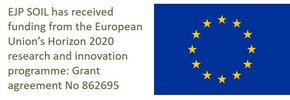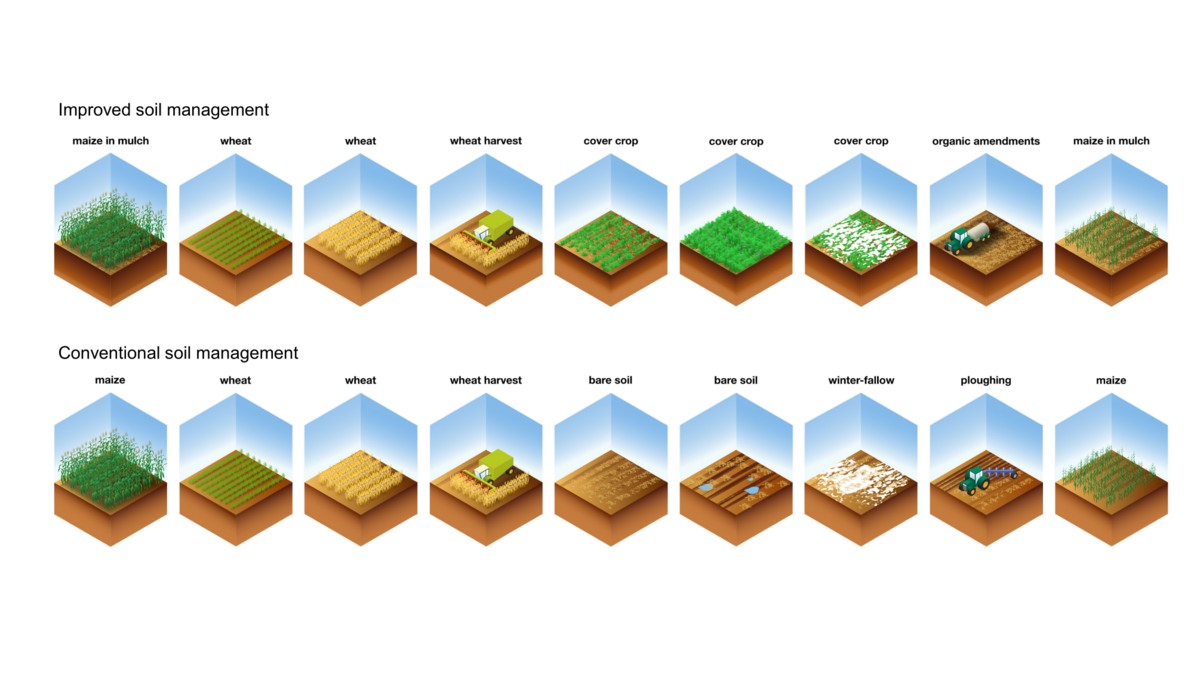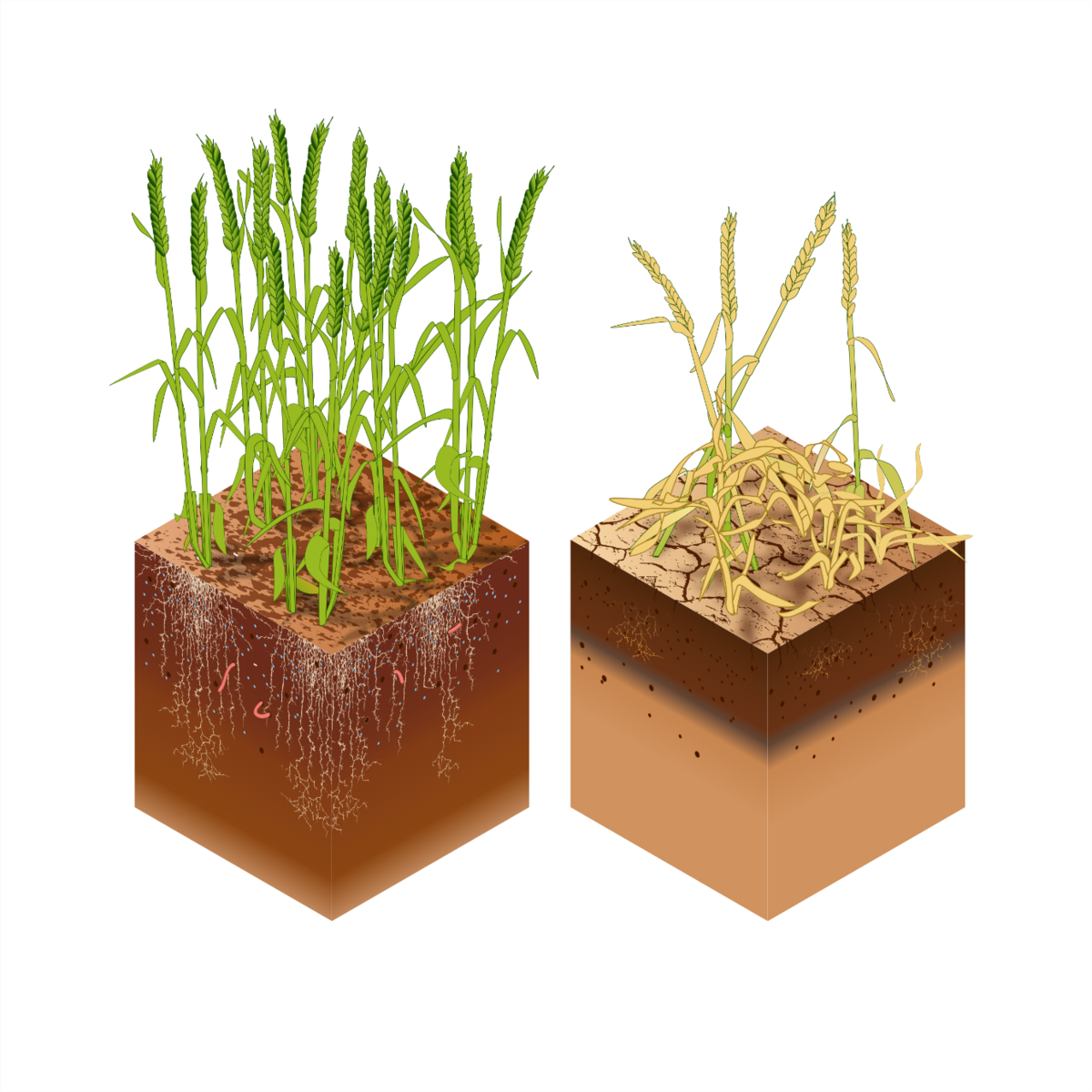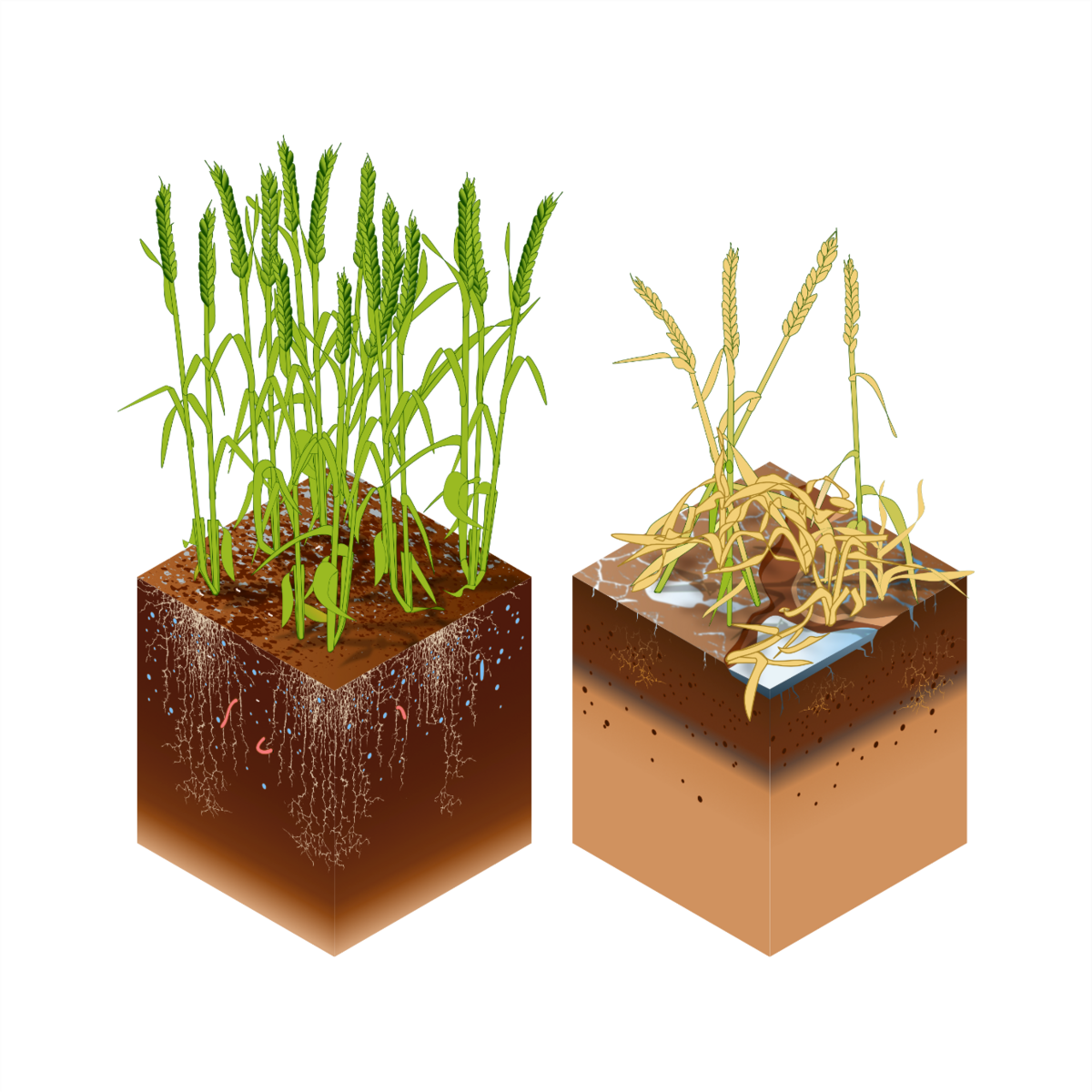SoilX
| Start: | 1 November 2022 |
| Duration: | 24 Months |
| Aim: | Soil management to mitigate climate change-related precipitation eXtremes |
| Keywords: | Soil hydrology, soil health, soil management, soil/crop systems modelling, climate adaptation; climate mitigation; sustainability; practice adoption; farmer behaviour |
| Contact: | Project coordinator: Annelie Holzkämper (annelie.holzkaemper@agroscope.admin.ch) (Agroscope) |

Project summary
With climate change, both drought and heavy precipitation are becoming more frequent. SoilX investigates the possibilities to mitigate impacts of such extremes on crop productivity and other ecosystem services (i.e. soil protection, nutrient cycling, carbon sequestration) through improved soil management practices. We are conducting a harmonized field sampling campaign across Europe to measure the impacts of soil management improvements on soil hydraulic characteristics. Based on existing and new measurements from this project, we will evaluate possible benefits and drawbacks of soil management changes with regard to productivity gains and other ecosystem services under current and future climate conditions. This work involves the use of several biophysical models to evaluate the robustness of impact estimates towards structural model uncertainties. Socio-economic factors that hinder or enable the adoption of improved soil management practices are identified through farmer interviews. The synthesis of the project findings will ultimately improve the knowledge base for advising farmers and policy makers at the European and regional levels and thus contribute to the successful implementation of soil structural improvement measures in Europe.
Project partners
- Aarhus University (https://international.au.dk/), Denmark: Lars Munkholm, Johannes Pullens, Loraine Ten Damme, Morten Graversgaard
- Agroscope (www.agroscope.admin.ch), Switzerland: Annelie Holzkämper, Johannes Köstel, Olivier Heller, Maria Eliza Turek, Nicole Bütikofer
- Czech University of Life Sciences, Czech Republic (https://www.czu.cz/en): Miroslav Fér, Jana Poláková
- Flanders Research Institute for Agriculture, Fisheries and Food (https://ilvo.vlaanderen.be/en/ ), Belgium: Tommy D’Hose, Sarah Garré
- National Institute for Agriculture and Food Research and Technology (https://www.inia.es), Spain: Marta Goberna, Inés Santín
- Swedish University of Agricultural Sciences (https://www.slu.se/en/), Sweden: Thomas Keller, Nicholas Jarvis, Katharina Meurer, Christina Lundström, Jenny Höckert, Anna Lindahl, Elsa Coucheney
- University of Natural Resources and Life Sciences (https://boku.ac.at/), Austria: Heidi Leonhardt, Bano Mehdi-Schulz, Pia Euteneuer, Klaus Salhofer, Michael Braito, Mariella Schreiber, Edberto Lima, Kristin Böning, Ernesto Lunar Koch
Soil management to mitigate climate change-related precipitation eXtremes (SoilX)
Both drought and heavy precipitation are becoming more frequent. SoilX is investigating how improvements in agricultural soil management can help mitigate the impacts of such extremes on cropping systems in Europe.
Lead:
Soil structure determines how much and how quickly water can infiltrate into the soil during heavy precipitation events, preventing surface runoff and erosion, and how much water can be taken up by plants. In SoilX, natural and social scientists are jointly investigating how improvements in the structure of European soils resulting from regenerative management practices will mitigate the adverse impacts of future drought and extreme precipitation.
Background
Within the previous EJPSoil project CLIMASOMA, a large meta-analysis had been conducted on the impacts of soil and crop management practices on climate change adaptation with a specific focus on soil hydrological functioning. It was found that two aspects of soil management can be considered particularly beneficial: (1) green cover at all times throughout the year, and (2) organic material to remain, be returned, or be added on the field as much as possible.
Building on these insights, SoilX hypothesizes that increasing soil carbon inputs is a key to improving the resilience of cropping systems to precipitation extremes such as drought and heavy rainfall. Specific soil management improvements that could contribute to this are:
- diversified crop rotations
- cover cropping
- organic amendments
- residue incorporation, and
- reduced tillage
Such improvements in soil management can contribute to an accumulation of organic carbon in the soil as the amount of organic material that enters the soil in the form of crop residues, plant roots, cover crop biomass, compost/manure is increased (Fig. 1). As a consequence, a greater biomass and abundance of soil microorganisms and fauna improves nutrient availability to crops making them less susceptible to abiotic and biotic stresses (Fig. 2). Soils under improved management practices may also have a greater water retention capacity, larger unsaturated hydraulic conductivity (and therefore faster rates of supply of water to crop roots), deeper rooting, and a larger infiltration capacity (Fig. 2), which reduces the risk of water-logging, surface run-off and soil loss. These improved physical conditions mean that crop production will be more resilient to drought and heavy rainfall extremes and the environmental impacts of agriculture will also be less (Figs. 3 and 4).

While several research studies have presented empirical evidence of the effects described above, it is not clear to what extent soil management improvements can contribute to climate adaptation in a given pedo-climatic context. It is thus the aim of SoilX to provide an integrated evaluation of the potential to mitigate climate change-related precipitation eXtremes in Europe by addressing the following three research questions:
- How did soil management alter soil hydraulic properties in long-term field experiments across Europe?
SoilX collects empirical evidence of the effects of soil management on the water regulation functions of the soil. For this purpose, the hydraulic properties of soils are measured in a uniform manner in long-term field experiments in 7 different European countries (Sweden, Denmark, Belgium, Switzerland, Spain, Austria, Czech Republic). The focus is on determining differences in soil structure driven by differences in the intensity of tillage and organic carbon inputs with varying crop rotations, catch crops or organic fertilizers. The measurements will show which soil structural improvements are achievable through management changes depending on the prevailing soil and climate conditions.
- Can soil structural improvements enhance the resilience of cropping systems to future precipitation extremes?
Selected biophysical models are used to estimate the benefits of soil structural improvements for mitigating the impacts of increasing precipitation extremes (i.e. drought and heavy precipitation) under climate change. In addition to influences on the soil water balance, the influences of soil structural changes on nutrient losses and plant growth are also evaluated in different regions of Europe. In this way, possible synergies and trade-offs between goals of climate adaptation, climate mitigation and resource-use-efficiency can be identified.
- Which socio-economic factors enable soil management improvements?
Socio-economic factors that hinder or enable the adoption of beneficial farming practices will be identified through farmer interviews. Farmers, agricultural advisors and representatives of regional offices will be directly involved in the project in all study regions. The synthesis of the project findings will ultimately improve the knowledge base for advising farmers and policy makers at the European and regional levels and thus contribute to the successful implementation of soil structural improvement measures in Europe.
Synthesized project findings will improve the basis of knowledge and evidence to provide better soil management advice for both farmers and policy makers in Europe.



